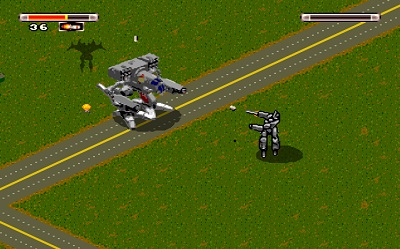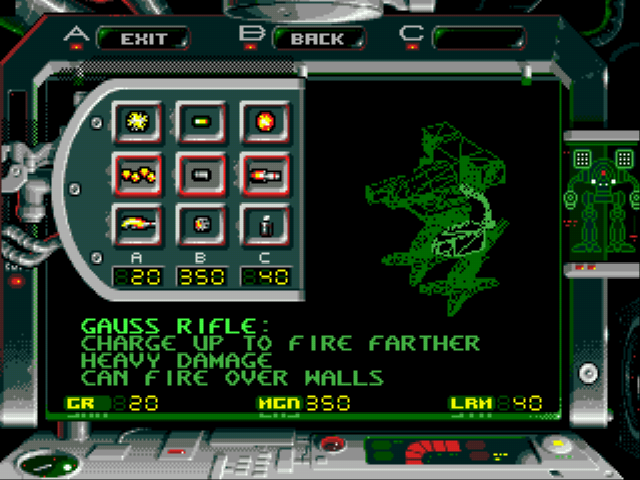BATTLETECH A Review by James Welch, March 27, 2016, at 4:03 p.m.
My earlier review was about the awesomely awesome Sega Genesis version of Shadowrun. In that review, I briefly mentioned how I was introduced to Shadowrun, via a FASA catalog, while I playing a BattleTech game. That, of course, brought up all kinds of repressed memories about the first Pen and Paper (PnP) RPG I had ever found to be palatable. Of course I’m talking about BattleTech (because, hey, let’s face it, giant robots are really, really cool).
So, waxing nostalgic, I had to throw BattleTech for the Sega Genesis into my, wait for it… Sega Genesis, and start playing. It didn’t take long for me to remember that games used to be significantly more difficult in the dark ages of the 16-Bit era. Dark Souls be damned; beat Castlevania 3 and I will be considerably more impressed. Beat BattleTech and, well, that’s not as impressive, but it is still more difficult than beating the majority of today’s auto-save-every-30 seconds games. Didn’t passwords suck? Having to be able to differentiate between the letter “l” and number “1” and “O” vs ”0” isn’t as easy as you think young bucks.
Wait, where was I? Castlevania 3, Shadowrun, oh yeah… BattleTech. What is BattleTech, you may ask? BattleTech is an isometric action/adventure game for the Sega Genesis set in the BattleTech universe. The BattleTech universe is set a thousand-plus years into the future when mankind has colonized much of the known galaxy.
While war wages constantly in this future, much of it is fought by giant, 50+ foot robots known as BattleMechs. BattleMechs are piloted by Mechwarriors, who are elite, highly trained pilots that are the crème de la crème of the military, using these towering monstrosities to wage war on all manner of enemies across this galaxy.
Here I go rambling again (I’m extremely good at that) so I will adjust fire and get back to the task at hand, Sega Genesis’ BattleTech. The game was developed in 1994 by the now defunct Malibu Interactive, and takes place during the “Clan Invasion” of 3050. You play a MechWarrior from the Clan Wolf, attacking various Inner Sphere assets, utilizing a Timber Wolf BattleMech. Yes, gibberish to the unenlightened, but that’s why God invented Wikipedia.
Let’s start with the graphics. BattleTech was released later in the Genesis’ life cycle, and, as such, BattleTech is one of the more graphically impressive games on the system. The enemies are easily recognizable, especially if you are a fan of the series. While the levels themselves are relatively nondescript, there is a decent variety (and quantity) of enemies to keep you from focusing on the semi-lackluster scenery.
That said, each planet you visit is represented by a different type of terrain, although, I will admit, it was a bit lazy level layout; grasslands to fire fields, to snow drifts, back to grasslands, and finally a swamp, but the levels provide just enough diversity to not become tedious. If the graphics played wide receiver for the Denver Broncos, they would be Rod Smith; nothing flashy, just really, really good.
BattleTech’s sound, honestly, is one of the more impressive aspects of the game. I’m serious. On a system known for its horribly emulated voices, the crystal clear voice of the game’s narrator is very impressive. “Enemy Mech Approaching,” will be burned into your brain upon game completion. The sound effects are, all around, superb; from the rat-a-tat-tat of the machine gun, to the rocket propelled “whoosh” of the Arrow-6 missiles.
The only weak spot is the music, which barely exists. The intro, the ending, and during mission briefings are the only times you will hear any tunes, and they aren’t exactly rockin’. The remarkable voice over of the narrator, as well as the in game sound effects, overshadow the absence of music, so the sound gets two unopposable gorilla thumbs up.
The gameplay is very similar to another isometric-view game, Desert Strike. Like Desert Strike, you have three independent weapon systems’, each with their own individual ammunition types; also both games have an armor pickup to restore health. One of the more interesting aspects of the game is the two player mode. The Timber Wolf’s movement is impressive, with the top portion of the chassis moving independent from the lower half; allowing a sense of control you didn’t get from most games of the era. The upper chassis controls your weapons, whereas the lower portion is for maneuvering around the battlefield.
In the one-player mode, you maintain control of the legs but have to rely on the limited auto-aim to really hit your targets. It works just fine, but the two player mode is where the game gets really interesting. Player one controls the weapon systems, and player two is in control of the Mech movement. Once you and your battle buddy get the basics down, it allows for a very unique two-player experience, unlike virtually every other co-op game.
Overall BattleTech is one of those games that went under the radar, especially with the success of its PC cousins (the MechWarrior series). Is it worth checking out and adding to your collection? You better believe it, Buster Brown. Good graphics, good sound, and great gameplay, along with one of the coolest co-op multiplayer modes of any game ever, make BattleTech one of the truly unsung gems of the Sega Genesis library. So grab a copy, fire up your Mad Cat, and prepare to issue a batch-all against the scum of the Inner Sphere. The clan patiently awaits your victory, Trueborn.

